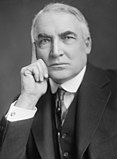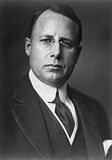| |||||||||||||||||||||||||||||||||
| Turnout | 56.4%[1] | ||||||||||||||||||||||||||||||||
|---|---|---|---|---|---|---|---|---|---|---|---|---|---|---|---|---|---|---|---|---|---|---|---|---|---|---|---|---|---|---|---|---|---|
| |||||||||||||||||||||||||||||||||
 County Results
Harding 50–60% 60–70% 70–80%
| |||||||||||||||||||||||||||||||||
| |||||||||||||||||||||||||||||||||
| Elections in New York State |
|---|
 |
The 1920 United States presidential election in New York took place on November 2, 1920. All contemporary 48 states were part of the 1920 United States presidential election. Voters chose 45 electors to the Electoral College, which selected the president and vice president.
New York was won by Republican Senator Warren G. Harding of Ohio, who was running against Democratic Ohio Governor James M. Cox. Harding's running mate was Governor Calvin Coolidge of Massachusetts, while Cox ran with Assistant Secretary of the Navy Franklin D. Roosevelt of New York. Also running that year was Socialist candidate Eugene V. Debs of Indiana and his running mate Seymour Stedman of Illinois.
Harding won New York State with an overwhelming landslide of 64.56% of the vote to Cox's 26.95%, a victory margin of 37.61%. Socialist Party candidate Eugene Debs finished with a relatively strong showing for a third party candidate, taking 7.01% of the vote, more than twice his national vote share, making New York his third strongest state in the nation. The strongest county for Debs within the state was the New York City borough of the Bronx, where Debs broke 15% of the vote.
With the deeply unpopular Democratic administration of Woodrow Wilson as the backdrop for the 1920 campaign,[2] Warren G. Harding promised a "return to normalcy" that appealed to many voters,[3] while Cox was tied to the policies of the Wilson administration, which had even in 1916 been criticized for insensitivity to Irish-American wishes.[4] Harding won nationally in one of the most decisive landslides in American history, and New York, already a fiercely Republican state during the Fourth Party System, went even harder for Harding than the nation, making New York a solid 12% more Republican than the national average.[5] The Irish-Americans were offended by Cox' close ties to Wilson's proposed League of Nations;[6] whilst Palatine Germans who had been the Democratic Party's other base in New York since before the Civil War were similarly offended by Wilson's pro-British policies. Schoharie County, which had been the only New York county to stay Democratic during the "free silver" election of 1896, went Republican for the first time ever[7] and has only twice voted Democratic since.[note 1]
- ^ Bicentennial Edition: Historical Statistics of the United States, Colonial Times to 1970, part 2, p. 1072.
- ^ McGerr, Michael E.; The Decline of Popular Politics: The American North, 1865-1928; p. 169 ISBN 0195363760
- ^ Carr, Richard and Hart, Bradley W.; The Global 1920s: Politics, Economics and Society, p. 143 ISBN 1317277872
- ^ Lichtman, Allan J.; Prejudice and the Old Politics: The Presidential Election of 1928, p. 103 ISBN 0739101269
- ^ Counting the Votes; New York
- ^ Yanoso, Nicole Anderson; The Irish and the American Presidency, p. 143 ISBN 1351480642
- ^ Phillips, Kevin P.; The Emerging Republican Majority, p. 121 ISBN 9780691163246
Cite error: There are <ref group=note> tags on this page, but the references will not show without a {{reflist|group=note}} template (see the help page).


